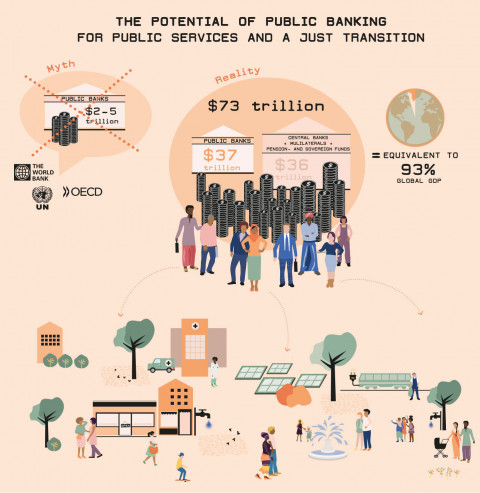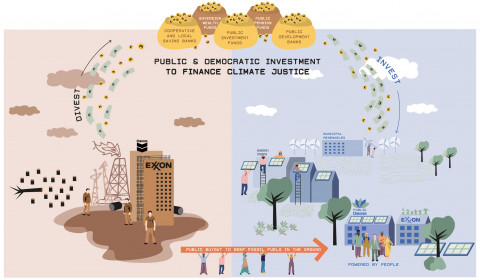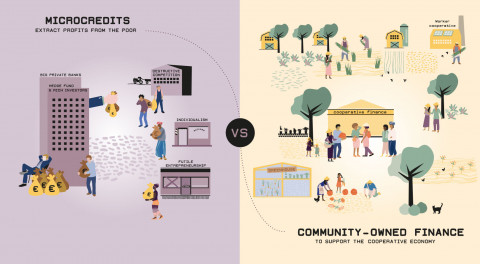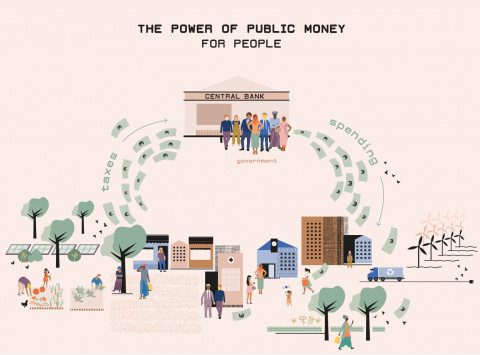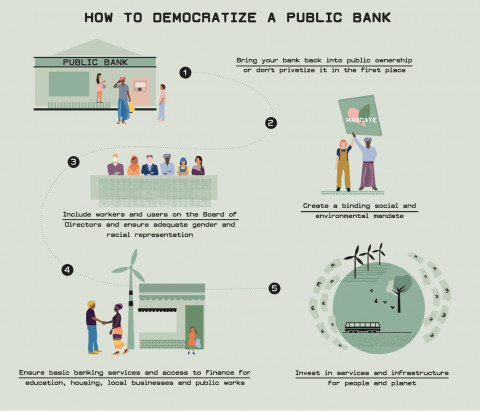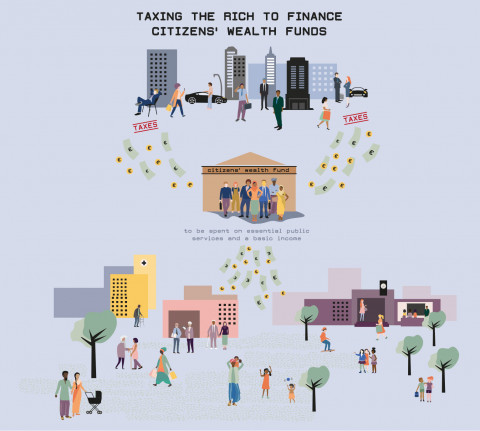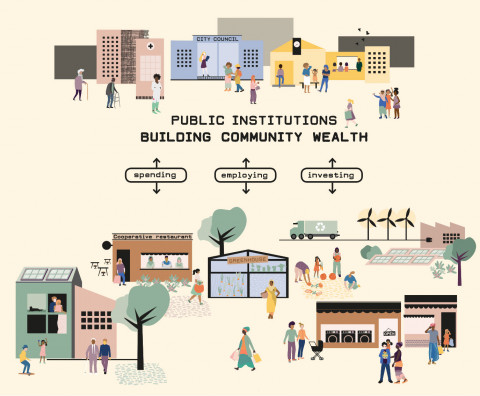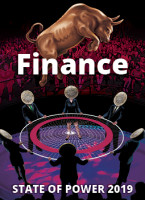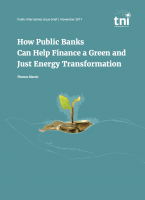Public Finance for the Future We Want
The real-world examples in this book demonstrate that a political economy that curbs the power of big finance and serves people and planet is possible. The ideas shared here are timely and urgent—a call to readiness before the next financial bubble bursts.
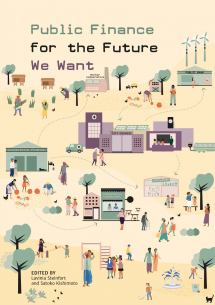
Downloads
-
Executive Summary - Public Finance for the Future We Want (PDF, 5.51 MB)Average time to read: 20 minutes minutes
Authors
After the 2008 global financial crisis, big banks were rescued and public spending was curtailed. This justified ever harsher austerity measures and reinforced a persistent myth that the public sector must rely on private finance to solve excessive inequality and ecological destruction.
Today, private finance has not only failed to address these problems, it has intensified them. The public does not have to rely on the private sector. Public funds are much bigger than we imagine: equivalent to 93 per cent of global GDP. Public banks have enough resources to raise the many trillions needed to invest in public services and climate infrastructure, without having to turn to private financiers.
This book presents visions of regenerative and redistributive economies, built with collective power: from the thriving cooperative economy in Kerala, India, to the hundreds of local saving banks in Germany, the worker-owned bank Banco Popular in Costa Rica, and the thousands of People’s Credit Funds in Vietnam. It explores models that could become the new normal— the basis for a democratically organised and life-sustaining future.
Contents
- Introduction: Public finance for a better future by Lavinia Steinfort
- Money for people by Mary Mellor
In the wake of the 2007 financial crisis, governments used the power of public money to rescue the banks and other large businesses, rather than to meet people’s needs. The governments’ privatization of money – and not money itself – perpetuates the pernicious cycle of debt and growth. Despite the rhetoric, states can and do ‘print money’. Their central banks produce money free of cost for the money-creating activities of the banking sector. And money is created and circulated as the government spends, in the same way that banks generate money as they lend. Clearly, it could be put in circulation for different purposes such as facilitating the provision of universal basic services and sustainable livelihoods for all. - Citizens' wealth fund, a powerful new economic and social instrument by Stewart Lansley and Duncan McCann
Financed by higher taxation on private wealth, citizens’ wealth funds could provide a progressive and comprehensive route to getting more social value from existing assets: public, personal and corporate. - From failed local neoliberalism to community-owned and controlled finance by Milford Bateman
For decades microcredit captured the zeitgeist of financial neoliberalism and its celebration of individualism, entrepreneurship and self-help. By the 2010s, however, it became clear that the microcredit model was no anti-poverty panacea, but a slow-moving disaster for the global poor. Meanwhile community-owned and controlled finance has successfully encouraged equitable development, as illustrated by four examples from Europe and Asia. - Kerala’s web of cooperatives: Advancing the solidarity economy by Benny Kuruvilla
In the southern Indian state of Kerala, Left parties, organized labour and people’s movements have ensured the continuity of cooperatives, social schemes and labour rights. This chapter is about how successful worker-run cooperatives function across the state despite the growing challenge of neoliberalism. Many of the individual cooperatives are connected through a web of cooperative finance, local governments and producer markets, and united in a movement to advance the solidarity economy. - Community wealth building and resilient local economies by Thomas M. Hanna
There is an urgent need to move away from a financial system designed to extract wealth from local communities. Instead our common goal should be to support efforts to build community wealth. By leveraging the procurement, investing, employment and other capacity of large-scale ‘anchor institutions’ – place-based public or non-profit organizations such as hospitals and universities – it becomes possible to build more resilient, equitable and sustainable local economies. - The social and solidarity economy and the rise of new municipalism by Ana Álvaro, Adrián Gallero, Miguel Ángel Martínez, Fernando Sabín and Sandra Salsón
This chapter provides an overview of the main policies and actions that municipalist governments in various Spanish cities are implementing to promote the social and solidarity economy. Throughout Spain, new public services models for water and energy are emerging, such as the users’ cooperative Comunitat Minera Olesana that manages the water services of Olesa de Montserrat. Combined with new participation and decision-making mechanisms for citizens, the social solidarity economy has emerged as an organized expression of economic citizenship. - Building bottom-up finance solutions for cooperative housing in Central and South-Eastern Europe by Agnes Gagyi
The MOBA Housing Network that came to life in 2017 is a collaboration of emerging cooperative housing initiatives in Central and South-Eastern Europe. MOBA, meaning ‘self-build through mutual help’ enables lower income populations in the region to collectively access finance for affordable housing. Pilot projects under way in Budapest, Ljubljana, Belgrade and Zagreb show it can provide stable, affordable, socially owned housing. The institutional framework that MOBA is building offers a model for systemic transformation of local housing markets everywhere. - Democratizing nationalized banks by Frank Vanaerschot
This chapter explores strategies to democratize Belgium’s public bank Belfius, which was nationalized in the aftermath of the 2008 financial crash. - Public banking on the future we want by Thomas Marois
Public banks are increasingly regarded by the international development community not as corrosive but as catalytic for investing in low-carbon infrastructure. This chapter shows that public banks have sufficient resources to lead the way in raising the required US$90 trillion in total and $6 trillion annually in climate infrastructure investments needed – without having to turn to private financiers. - Public investment for financial system change not climate change by Oscar Reyes
This chapter looks at how state-owned banks, cooperative and local saving banks, public pension funds and investment funds can shift their investment in the public interest, addressing climate change and social justice. - Boosting investment: Breaking the straitjacket of the Eurozone by Ludovic Suttor-Sorel
The scale of the challenge that climate change and nature’s depletion presents calls for strategic, long-term capital. Yet, largely as a consequence of European Union (EU) fiscal rules that institutionalized a permanent reduction in public spending, public investment in the region is at an all-time low. This chapter argues that the potential of state investment banks has been largely overlooked, and too often restricted to de-risking private investment. - A public buyout to keep carbon in the ground and dissolve climate opposition by Carla Santos Skandier
Real solutions to the climate crisis must go beyond demand and include the supply side. The United States can do this by using its sovereign monetary power to dismantle extractive companies as part of a Green New Deal to mitigate climate change and address social and economic inequalities. The most straightforward way to untangle the paralyzing relationship between government and the Big Oil industry is through a federal buyout of the fossil fuel companies that control these noxious assets.
- Conclusion: Tools for transformation
This book is published by Transnational Institute (TNI), The Democracy Collaborative, Change Finance, Focus on the Global South, New Economics Foundation, Fairfin, MOBA Housing Network and Tellus Institute.
Infographics
